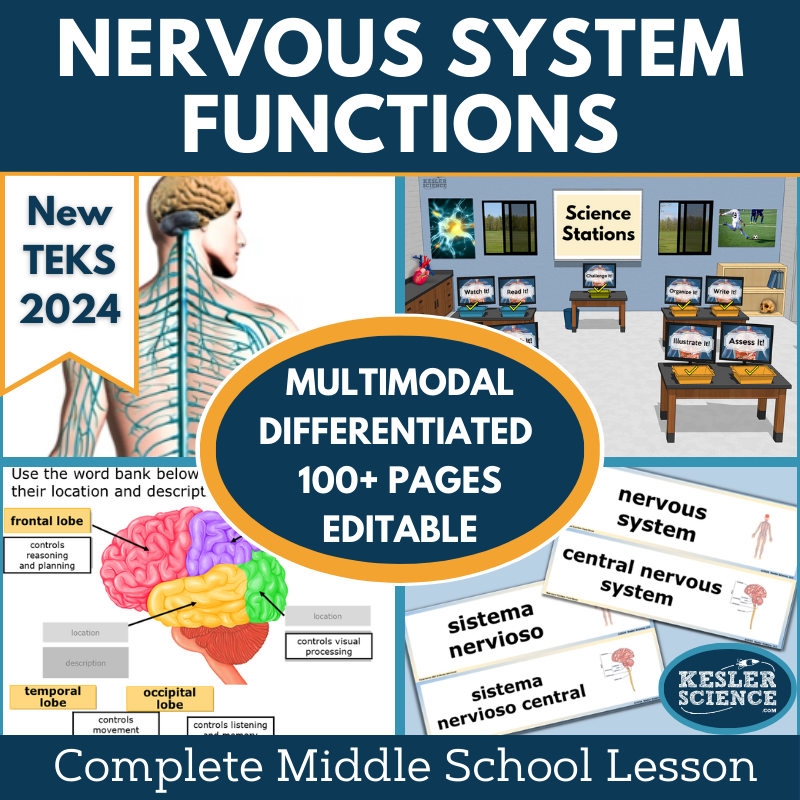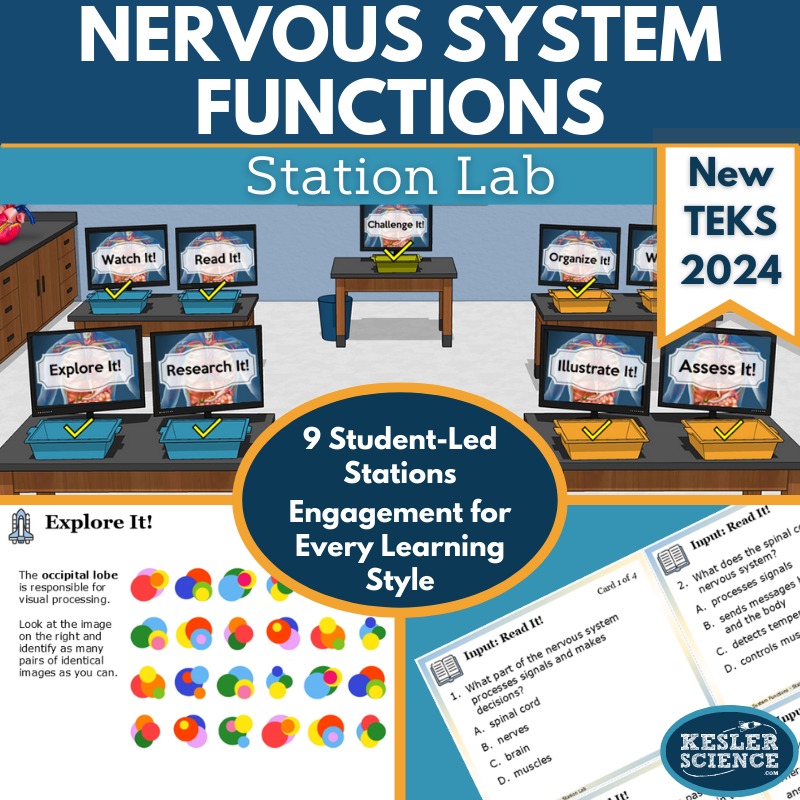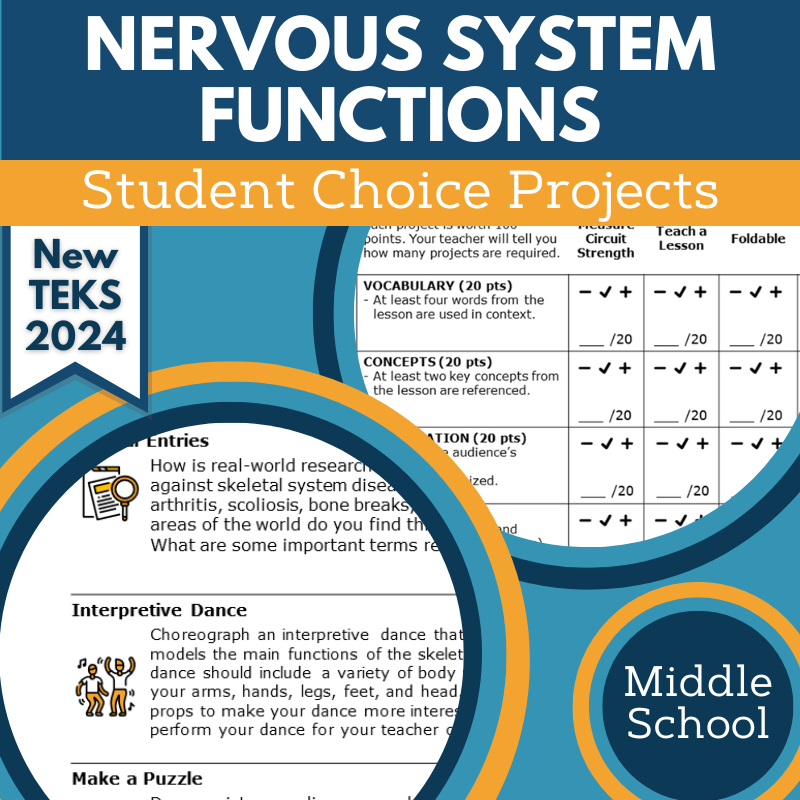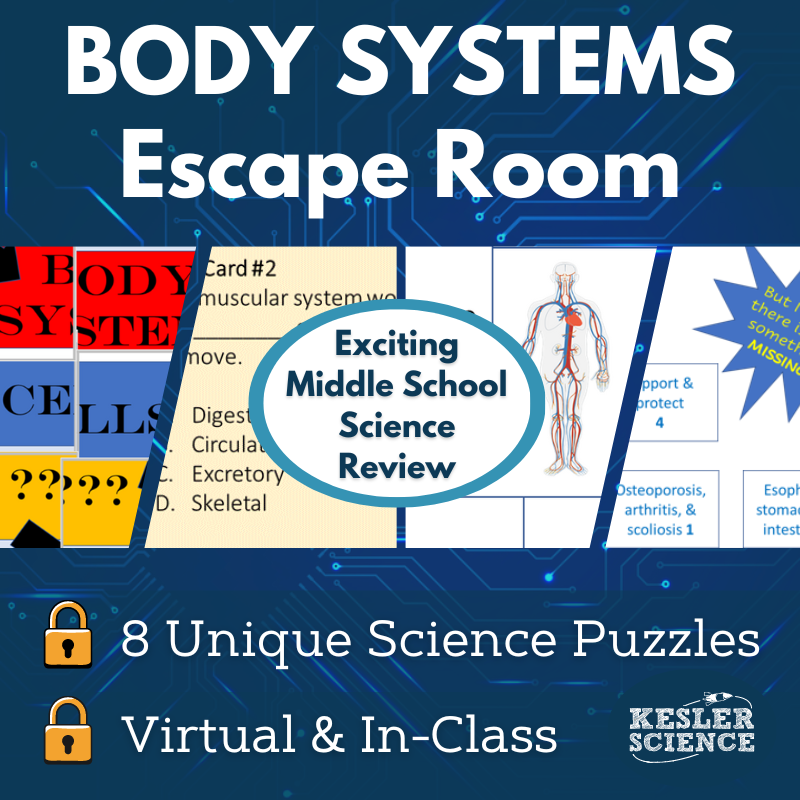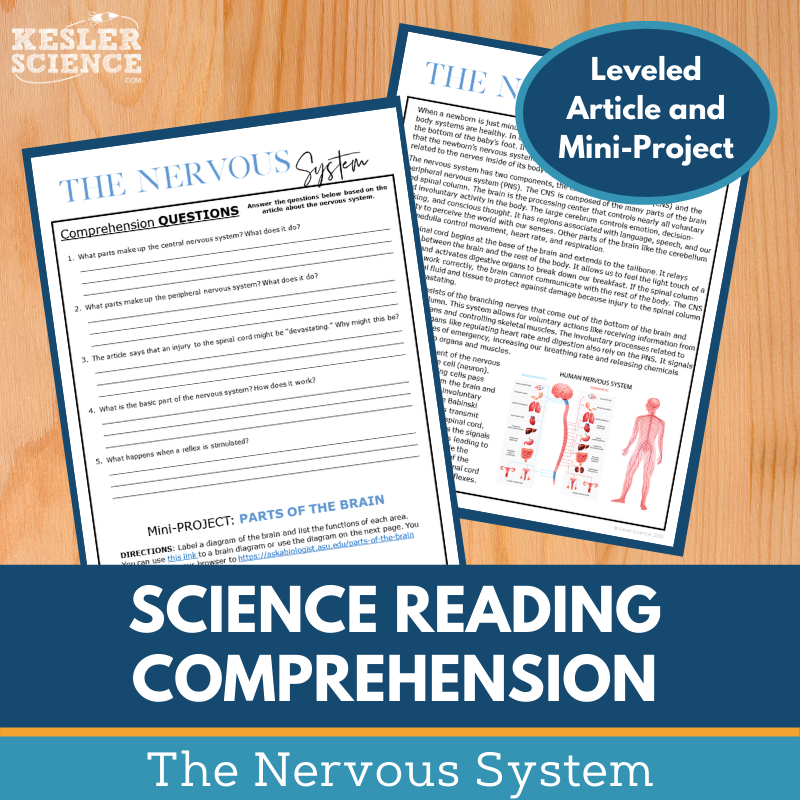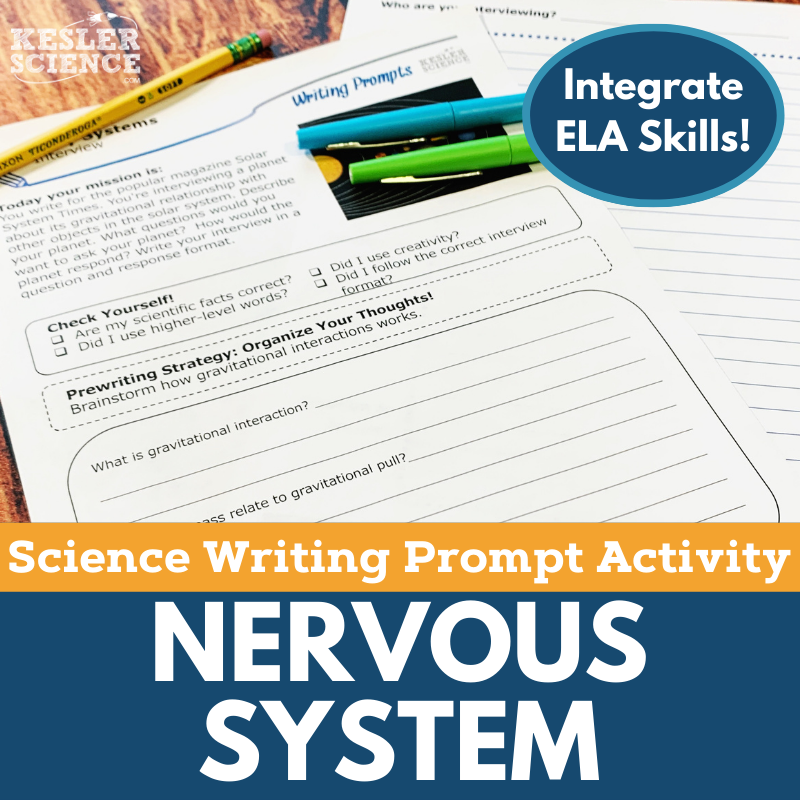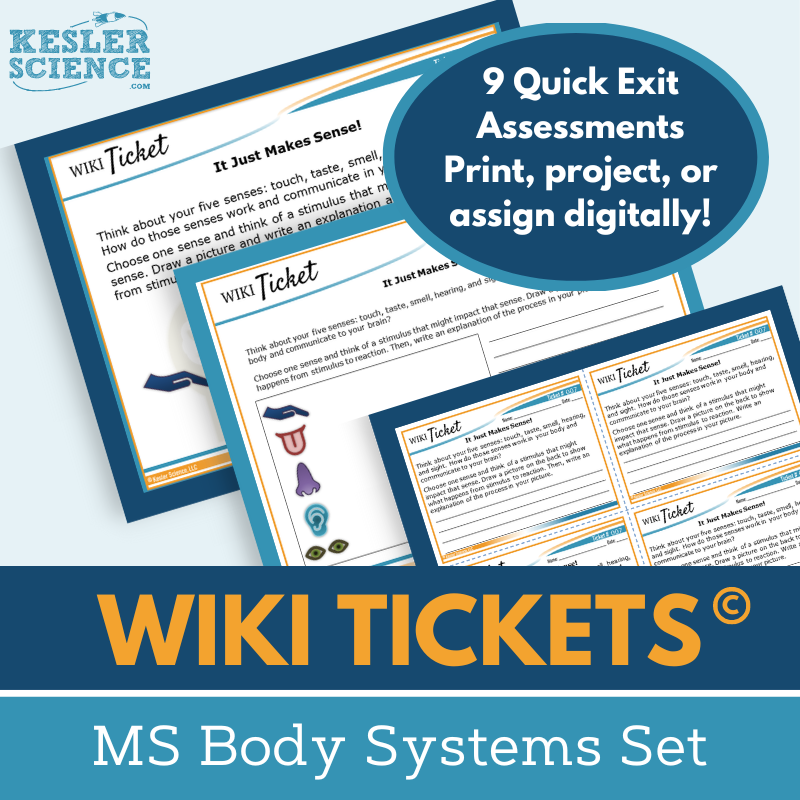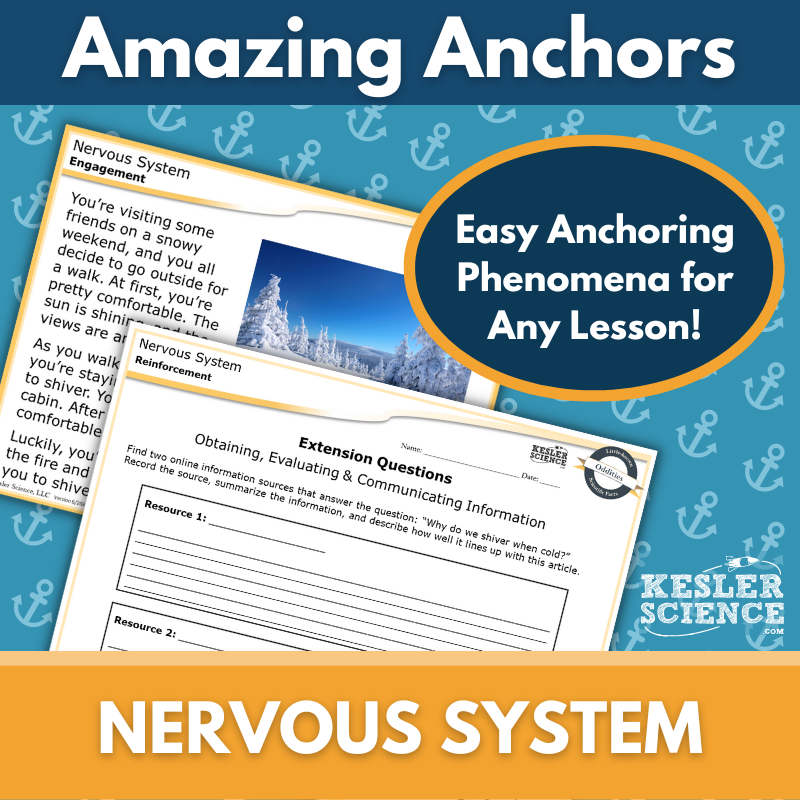Nervous System Functions Activities for Middle School Science
Explore the role of the nervous system in sending and receiving information with this engaging 5E lesson designed for middle school anatomy studies. The resources below will give students a comprehensive understanding of the nervous system. All of the following materials are also included in the Kesler Science Membership.
The Kesler Science Nervous System 5E Lesson is a comprehensive, student-led unit designed for middle school anatomy studies. It explores the role of the nervous system in sending and receiving information through engaging, differentiated activities. The lesson includes editable PowerPoints, worksheets, choice projects, assessments, and Spanish translations of key materials.
Following the 5E Model, the unit begins with engaging class discussions and activities. Students then explore the nervous system through a hands-on, multimodal station lab with nine interactive stations, including reading passages, videos, experiments, and categorization tasks. Explanation resources include editable presentations, interactive notebooks, and note-taking templates. Elaboration activities extend learning through student-choice projects, while evaluation includes STAAR 2.0-aligned assessments and review worksheets.
The lesson is fully flexible for in-class or virtual learning, with both digital and printable options. It aligns with the 2021 TEKS 7.13A standard, ensuring thorough coverage of the nervous system's functions.
The Kesler Science Nervous System 5E Lesson is a comprehensive, student-led unit designed for middle school anatomy studies. It explores the role of the nervous system in sending and receiving information through engaging, differentiated activities. The lesson includes editable PowerPoints, worksheets, choice projects, assessments, and Spanish translations of key materials.
Following the 5E Model, the unit begins with engaging class discussions and activities. Students then explore the nervous system through a hands-on, multimodal station lab with nine interactive stations, including reading passages, videos, experiments, and categorization tasks. Explanation resources include editable presentations, interactive notebooks, and note-taking templates. Elaboration activities extend learning through student-choice projects, while evaluation includes STAAR 2.0-aligned assessments and review worksheets.
The lesson is fully flexible for in-class or virtual learning, with both digital and printable options. It aligns with the 2021 TEKS 7.13A standard, ensuring thorough coverage of the nervous system's functions.
Engage your students with this student-led station lab on nervous system functions, aligned with the 2021 TEKS 7.13A standard. Designed for in-class or virtual learning, this interactive lesson allows students to explore and model the main functions of the nervous system through nine differentiated stations.
Students encounter new concepts through hands-on exploration, video analysis, reading comprehension, and research activities. They demonstrate their understanding by organizing information, illustrating models, writing responses, and completing assessments. A bonus challenge station offers extension activities for advanced learners. Differentiated reading passages in English and Spanish support varied learning needs.
This low-prep, high-engagement resource encourages active learning and critical thinking, making it a valuable addition to your life science curriculum.
Engage your students with this student-led station lab on nervous system functions, aligned with the 2021 TEKS 7.13A standard. Designed for in-class or virtual learning, this interactive lesson allows students to explore and model the main functions of the nervous system through nine differentiated stations.
Students encounter new concepts through hands-on exploration, video analysis, reading comprehension, and research activities. They demonstrate their understanding by organizing information, illustrating models, writing responses, and completing assessments. A bonus challenge station offers extension activities for advanced learners. Differentiated reading passages in English and Spanish support varied learning needs.
This low-prep, high-engagement resource encourages active learning and critical thinking, making it a valuable addition to your life science curriculum.
The Nervous System Functions Student Choice Projects align with the 2021 TEKS standard 7.13A, allowing middle school students to select a project that matches their preferred output style. A project page outlines six student-led options plus a “design your own” project, with an editable rubric for teacher, peer, or self-assessment. This resource is also included in the Nervous System Functions Complete Lesson for TEKS 7.13A.
These flexible, multimodal projects provide creative ways for students to demonstrate their understanding. Two versions of the project page support differentiation, with modified options for students needing remediation and challenge opportunities for advanced learners. Teachers can adjust the rubric to fit grading needs.
The projects use standard classroom supplies like paper, markers, and scissors, and many can be completed digitally.
The Nervous System Functions Student Choice Projects align with the 2021 TEKS standard 7.13A, allowing middle school students to select a project that matches their preferred output style. A project page outlines six student-led options plus a “design your own” project, with an editable rubric for teacher, peer, or self-assessment. This resource is also included in the Nervous System Functions Complete Lesson for TEKS 7.13A.
These flexible, multimodal projects provide creative ways for students to demonstrate their understanding. Two versions of the project page support differentiation, with modified options for students needing remediation and challenge opportunities for advanced learners. Teachers can adjust the rubric to fit grading needs.
The projects use standard classroom supplies like paper, markers, and scissors, and many can be completed digitally.
The Nervous System Inquiry Lab aligns with TEKS, allowing students to compare how the nervous system processes information visually, orally, and tactually. This resource includes three differentiated labs designed to support various learning needs.
Each lab version offers different levels of guidance: the Dependent Student Lab provides structured inquiry with guided questions, the Modified Student Lab simplifies the process with sentence stems and multiple-choice questions, and the Independent Student Lab encourages students to take control of the investigation with minimal guidance. Reflection questions guide students through claim, evidence, and reasoning statements.
Teacher resource pages include preparation details, objectives, materials, and answer keys. All pages are editable for customization. A meter stick is needed per group for hands-on engagement. This lab provides an interactive approach to understanding the nervous system’s role in processing sensory information.
The Nervous System Inquiry Lab aligns with TEKS, allowing students to compare how the nervous system processes information visually, orally, and tactually. This resource includes three differentiated labs designed to support various learning needs.
Each lab version offers different levels of guidance: the Dependent Student Lab provides structured inquiry with guided questions, the Modified Student Lab simplifies the process with sentence stems and multiple-choice questions, and the Independent Student Lab encourages students to take control of the investigation with minimal guidance. Reflection questions guide students through claim, evidence, and reasoning statements.
Teacher resource pages include preparation details, objectives, materials, and answer keys. All pages are editable for customization. A meter stick is needed per group for hands-on engagement. This lab provides an interactive approach to understanding the nervous system’s role in processing sensory information.
The Body Systems Escape Room is an interactive experience that allows students to demonstrate their understanding of the major body systems, including their structures and functions. Prior knowledge of these systems is necessary before participating.
This escape room gives teachers full control over the eight independent puzzles, allowing customization based on class time and student needs. It can be conducted using manila envelopes and passwords or a more authentic lock-and-box setup. A digital version is available for online learning via PowerPoint or Google Slides, with printable versions for home use.
The resource includes teacher directions, a detailed answer key, a digital answer sheet for Google Classrooms, editable templates, video challenges, and engaging props. Students will work through puzzles using various materials, such as a mirror, red cellophane, or an optional UV pen and flashlight. Reward templates, over 50 prize ideas, and fun photo signs enhance the experience, making this a memorable, standards-aligned learning activity.
The Body Systems Escape Room is an interactive experience that allows students to demonstrate their understanding of the major body systems, including their structures and functions. Prior knowledge of these systems is necessary before participating.
This escape room gives teachers full control over the eight independent puzzles, allowing customization based on class time and student needs. It can be conducted using manila envelopes and passwords or a more authentic lock-and-box setup. A digital version is available for online learning via PowerPoint or Google Slides, with printable versions for home use.
The resource includes teacher directions, a detailed answer key, a digital answer sheet for Google Classrooms, editable templates, video challenges, and engaging props. Students will work through puzzles using various materials, such as a mirror, red cellophane, or an optional UV pen and flashlight. Reward templates, over 50 prize ideas, and fun photo signs enhance the experience, making this a memorable, standards-aligned learning activity.
This Human Nervous System Science Reading Comprehension Lesson helps students explore the main structures and functions of the nervous system through a nonfiction article, comprehension questions, and a brain labeling activity. Designed for grades 6-8 (and advanced 5th graders), the leveled passage supports science literacy and reading comprehension.
The resource includes two Lexile-leveled articles (1100-1300), five to seven comprehension questions, a hands-on mini-project, and a Cornell notes template. Engaging, colorful graphics are included and can be printed in grayscale.
Perfect for sub plans, extra credit, ISS, or whole-class instruction, this resource fosters critical thinking, classroom discussions, and textual analysis while reinforcing key nervous system concepts. It is compatible with Google Classroom, MS Teams, Schoology, and Canvas, allowing students to respond directly in an editable document for virtual or in-person learning.
This Human Nervous System Science Reading Comprehension Lesson helps students explore the main structures and functions of the nervous system through a nonfiction article, comprehension questions, and a brain labeling activity. Designed for grades 6-8 (and advanced 5th graders), the leveled passage supports science literacy and reading comprehension.
The resource includes two Lexile-leveled articles (1100-1300), five to seven comprehension questions, a hands-on mini-project, and a Cornell notes template. Engaging, colorful graphics are included and can be printed in grayscale.
Perfect for sub plans, extra credit, ISS, or whole-class instruction, this resource fosters critical thinking, classroom discussions, and textual analysis while reinforcing key nervous system concepts. It is compatible with Google Classroom, MS Teams, Schoology, and Canvas, allowing students to respond directly in an editable document for virtual or in-person learning.
The Nervous System Science Writing Prompt Activity engages middle school students in a creative, invention-based writing exercise to reinforce their understanding of the nervous system. Aligned with TEKS, this activity supports science reasoning and exploration while allowing for both in-person and virtual learning.
This resource includes teacher directions with an answer guide, project ideas, and rubrics, as well as projection and print handouts in both full-sized and half-sheet formats. A digital interactive version in PowerPoint, compatible with Google Slides, is also included. Ideal for cross-curricular activities, pre-test assessments, student choice projects, early finisher enrichment, extra credit, make-up work, and differentiation, this writing prompt fosters engagement and creativity. It can also serve as a TELPAS sample or be displayed on a bulletin board or collected in a student anthology. Note that these prompts are designed for review and assume prior knowledge of the topic or access to research materials.
The Nervous System Science Writing Prompt Activity engages middle school students in a creative, invention-based writing exercise to reinforce their understanding of the nervous system. Aligned with TEKS, this activity supports science reasoning and exploration while allowing for both in-person and virtual learning.
This resource includes teacher directions with an answer guide, project ideas, and rubrics, as well as projection and print handouts in both full-sized and half-sheet formats. A digital interactive version in PowerPoint, compatible with Google Slides, is also included. Ideal for cross-curricular activities, pre-test assessments, student choice projects, early finisher enrichment, extra credit, make-up work, and differentiation, this writing prompt fosters engagement and creativity. It can also serve as a TELPAS sample or be displayed on a bulletin board or collected in a student anthology. Note that these prompts are designed for review and assume prior knowledge of the topic or access to research materials.
The Body Systems WIKI Tickets© provide engaging formative assessments for 6th-8th grade science, offering flexible ways to check student understanding. This set includes nine assessments covering the circulatory, digestive, endocrine, excretory, muscular, nervous (including senses), respiratory, and skeletal systems. Each topic is available in five formats: a full-screen display for projection, three printable handout versions, and an interactive digital option in PowerPoint or Google Slides.
Aligned with NGSS and TEKS standards, these assessments can be used as exit tickets, bellringers, or quick progress checks in both in-person and virtual learning settings. Students can respond on their own paper, use printed handouts, or complete the digital version in a 1:1 or remote learning environment. A bonus table of contents file is included to show standard alignment. WIKI Tickets© provide a versatile and engaging way to assess student learning throughout the year.
The Body Systems WIKI Tickets© provide engaging formative assessments for 6th-8th grade science, offering flexible ways to check student understanding. This set includes nine assessments covering the circulatory, digestive, endocrine, excretory, muscular, nervous (including senses), respiratory, and skeletal systems. Each topic is available in five formats: a full-screen display for projection, three printable handout versions, and an interactive digital option in PowerPoint or Google Slides.
Aligned with NGSS and TEKS standards, these assessments can be used as exit tickets, bellringers, or quick progress checks in both in-person and virtual learning settings. Students can respond on their own paper, use printed handouts, or complete the digital version in a 1:1 or remote learning environment. A bonus table of contents file is included to show standard alignment. WIKI Tickets© provide a versatile and engaging way to assess student learning throughout the year.
Lesson Extensions provide engaging, student-choice activities designed to challenge early finishers and deepen their understanding of body systems. These activities support critical thinking, creativity, and problem-solving while aligning with NGSS and TEKS standards. They are perfect for wrapping up lessons, filling downtime, and keeping students engaged with rigorous yet enjoyable learning opportunities.
Each extension includes four interactive components: Puzzler for problem-solving, Maker Space for hands-on STEAM activities, Tech Connection for digital demonstrations, and Word Master for creative writing. With teacher directions, answer keys, and both print and projection versions, these extensions provide flexible, high-level resources for independent learning and enrichment.
Covering topics such as the circulatory, digestive, endocrine, excretory, integumentary, muscular, nervous, respiratory, and skeletal systems, as well as sensory information, these extensions ensure students explore middle school anatomy and physiology in a meaningful way.
Lesson Extensions provide engaging, student-choice activities designed to challenge early finishers and deepen their understanding of body systems. These activities support critical thinking, creativity, and problem-solving while aligning with NGSS and TEKS standards. They are perfect for wrapping up lessons, filling downtime, and keeping students engaged with rigorous yet enjoyable learning opportunities.
Each extension includes four interactive components: Puzzler for problem-solving, Maker Space for hands-on STEAM activities, Tech Connection for digital demonstrations, and Word Master for creative writing. With teacher directions, answer keys, and both print and projection versions, these extensions provide flexible, high-level resources for independent learning and enrichment.
Covering topics such as the circulatory, digestive, endocrine, excretory, integumentary, muscular, nervous, respiratory, and skeletal systems, as well as sensory information, these extensions ensure students explore middle school anatomy and physiology in a meaningful way.
This Amazing Anchors Phenomenon Lesson introduces the nervous system through the real-world concept of getting the shivers. An introductory reading with comprehension and extension questions prepares students for deeper learning, followed by an explanatory reading that simplifies the science behind the nervous system with additional reinforcement questions.
Aligned with TEKS and NGSS, this no-prep resource includes teacher directions, answer keys, projection slides, and both print and digital formats for Google Classroom and other LMS platforms. A differentiated version provides sentence starters for student support. Designed to bookend a lesson, these engaging readings supplement and reinforce learning in any in-person or virtual classroom.
This Amazing Anchors Phenomenon Lesson introduces the nervous system through the real-world concept of getting the shivers. An introductory reading with comprehension and extension questions prepares students for deeper learning, followed by an explanatory reading that simplifies the science behind the nervous system with additional reinforcement questions.
Aligned with TEKS and NGSS, this no-prep resource includes teacher directions, answer keys, projection slides, and both print and digital formats for Google Classroom and other LMS platforms. A differentiated version provides sentence starters for student support. Designed to bookend a lesson, these engaging readings supplement and reinforce learning in any in-person or virtual classroom.
Year-Round Resources
These year-round activities will increase your students' understanding of many middle school science topics. All of these activities are also included in the Kesler Science Membership.
Visual Data & Graphing
You're not alone if your students struggle with understanding graphs, charts, and tables. It's a skill that takes an enormous amount of practice. This resource will help students build a strong foundation in analyzing data and creating their own data visualizations.
Bell Ringers and Warm-Ups
These middle school science bell ringers are an excellent way to engage your students as soon as they walk into your classroom. This comprehensive FULL YEAR resource includes everything you need to start off each science class with an interesting warm-up activity.
Review Board Games
Each game board has been carefully designed to keep students engaged. There are 10 different action spaces on each board and dozens of question cards. All of the actions are related to science concepts and keep the students motivated throughout the game.
Each game is ready to play. Simply print out the board and the cards and let the students enjoy reviewing nine different units.
Essential Questions and Standards
Below are the essential questions and standards associated with the lessons and activities included in the atoms unit. This topic is only one of more than 100 middle school science topics included in the Kesler Science Membership.
-
What is the main function of the nervous system?
-
How can we model the main functions of these tissues and organs?
-
TEKS Science - 7.13A Nervous System Functions
Kesler Science Membership
Imagine never having to search for another middle school science lesson again. The membership gives you access to ALL of the Kesler Science products in one place (Yes, including everything above).
Say goodbye to long hours of lesson prep.

